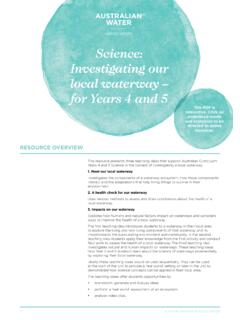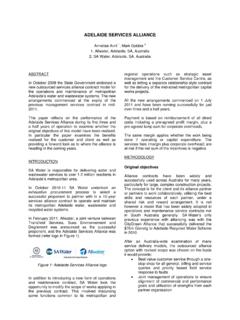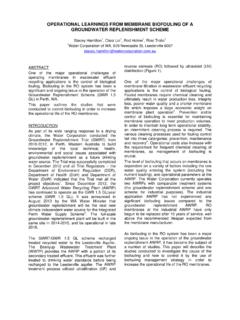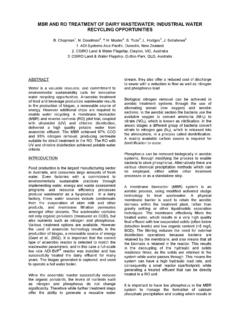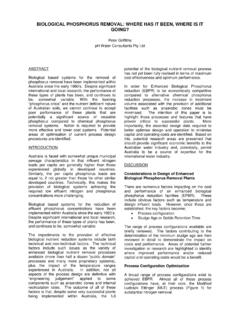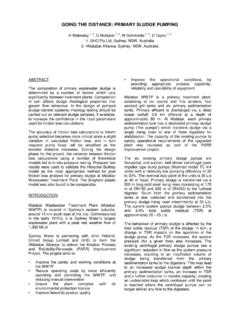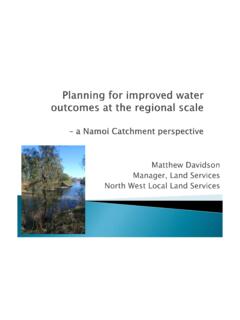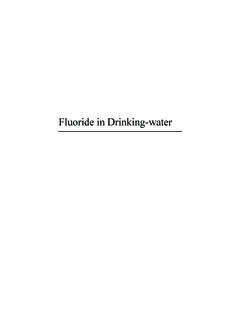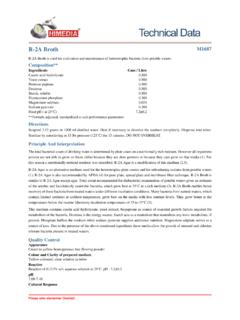Transcription of BIOLOGICAL TREATMENT FOR DRINKING WATER
1 BIOLOGICAL TREATMENT FOR DRINKING WATER Jesus Ortiz Mingo ACCIONA Agua, Adelaide, SA, Australia ATJV, Mundaring, WA, Australia WATER Corporation, Leederville, WA, Australia ABSTRACT In our ever expanding world clean unpolluted raw WATER sources for conventional DRINKING WATER TREATMENT plants are becoming scarcer. Furthermore we demand reliable high quality potable WATER and are constantly looking for more the most sustainable solutions technology can provide. It is a combination of these factors which encourage us to question whether we can do things better.
2 In municipal TREATMENT plants BIOLOGICAL TREATMENT is typically associated with wastewater processes and consequentially there are currently no recognised standards for the removal of organics in the production of DRINKING WATER , even though this is becoming a more common requirement. The objective of this paper therefore is to analyse the design and performance of the BIOLOGICAL removal of organic matter adopted in the Mundaring WATER TREATMENT Plant in Western Australia. INTRODUCTION It is well known for decades that the BIOLOGICAL activated carbon (BAC) TREATMENT , by adsorption by the activated carbon and biodegradation of bacteria attached on the activated carbon, is one of the most suitable and economical processes for the effective removal of organic contaminants (Nguyen et al.)
3 , 2013; Jusoh et al., 2011), precursors of disinfection (DBP) (Chu et al., 2012), taste and odour of the WATER , and therefore we have seen it more commonly being used in recent years. In many WATER TREATMENT plants and studies, ozone is used in pre-oxidation prior to biofiltration as without it the biorefractory substances are difficult to remove. Ozonization produces changes in the structures of the humic acids decreasing the UV absorbance and colour of the WATER due to a loss of aromaticity and depolimerization (Camel. V. et al.,1998), increasing the concentration of assimilable organic carbon (AOC), changing the molecular structure to lower molecular weight compounds to more assimilables such oxalic acid, which improves the biodegradation of the organic matter (Chien et al.
4 , 2007). Together with activated carbon, conventional treatments such a coagulation, have been used for the removal of organics, as in recent studies by Pramanik et al. (2014) where coagulation and granular activated carbon (GAC) were compared with the performance of the organic removal of the BIOLOGICAL activated carbon removal contaminants reclamation has increased over the past years as it has many advantages over the treatments and distribution systems downstream, as it is shown for example in a pilot scale study in Melbourne by Roddick et al.(2014). A BIOLOGICAL activated carbon (BAC) filtration was investigated as a pre- TREATMENT for reducing the organic fouling of a microfiltration membrane demonstrating the potential of BAC pre- TREATMENT for reducing organic fouling and thus allowing a higher sustainable flux for microfiltration.
5 Post chlorination, in even mildly polluted waters unwanted disinfection by products (DBPs) can be generated as a result of natural organic matter (NOM) in the WATER sources which may form carcinogenic components such as haloacetic acids (HAAs) and trihalomethanes (THMs). The NOM can also allow microorganism regrowth in WATER supply networks ( Lou et al., 2009 and 2010). Product WATER from WATER TREATMENT plants can be chemically complex resulting in physical and BIOLOGICAL changes during transportation in the distribution systems before reaching us, the consumers.
6 The regrowth, specially pathogens can have a significant impact on public health. Non-pathogens can also lead to biocorrosion and taste issues, therefore, a focus on the biostability of WATER and the associated controls are being adopted as they are very useful tools for today s distribution systems.(Chao Chen et al., 2013). The objective of this paper is to evaluate the effectiveness of conventional WATER TREATMENT plant NOM removal in the Mundaring WATER TREATMENT Plant in Western Australia. The process adopted is based on enhanced coagulation, a combined flotation and enhanced filtration system (DAFF), a BIOLOGICAL Activated Carbon system (BAC), Chloramination and Stabilisation in order to achieve a biologically safe and chemically stable WATER , with a focus on disinfection by products (DPB) and biostability of the WATER downstream of the plant, all in accordance with WATER Corporation and Australian DRINKING WATER Standards.
7 MATERIALS AND METHODS Process Units: Enhanced Coagulation. Enhanced coagulation of the raw WATER is carried out by optimising the pH of the inlet WATER with CO2. Aluminium sulphate is used as the coagulant with a polyelectrolyte to maximise coagulant effectiveness. DAFF. Dissolved air flotation is combined with a dual media filter comprising sand and expanded clay in a single process unit. The expanded clay provides long filtration times between backwashing, lower backwashing rates, high resistance to blinding by algal blooms and extra DOC removal properties compared with sand and or sand and anthracite, due primarily to its greater surface area.
8 Air for flotation is obtained by pressurising approximately 8-10% of the filtered WATER at 5 -7 bar, almost saturating this flow with dissolved air. When released through a proprietary pressurisation outlet nozzle, pressure is instantaneously reduced and a uniform mass of micro-bubbles are released which ascends through the entire surface of the process unit. Under normal operation the DAFF filtration rate is m/h and m/h with one filter under backwash. BAC. BAC filtration captures naturally occurring biology in a controlled way to remove organics through bio-assimilation.
9 The BAC design is based on an empty bed contact time (EBCT) of 16 minutes at full flow. This process leads to very long bed life (typically 10 15 years) and the selective removal of those contaminants that can cause taste, odour, chlorine decay, trihalomethane (THM) formation and biofilm regrowth in the distribution network. Filtration media selection in terms of type, size and bed depth for both DAFF and BAC is critical to ensure optimal process functionality without blinding or over frequent backwashing. Treated WATER Quality: Chlorine gas and small amounts of ammonia are added to the main flow, reacting together to form chloramine.
10 Due to long transmission lines, the treated WATER target for total chlorine is mg/l, with a tolerance of mg/l and the limit for turbidity is NTU. Sample collection Samples were collected from raw WATER inflow, post DAFF, post BAC and post chloramination were measured using the online instrumentation which was calibrated and verified using laboratory wet samples. WATER quality analysis WATER samples were filtered through a m glass membrane filter prior to DOC and UV254 measurements. The UV254 absorbance of the WATER samples was determined using a DR 6000 Spectrophotometer (Hach) with a 1 cm quartz cell.
